
Juncaceae is a family of flowering plants, commonly known as the rush family. It consists of 8 genera and about 464 known species of slow-growing, rhizomatous, herbaceous monocotyledonous plants that may superficially resemble grasses and sedges. They often grow on infertile soils in a wide range of moisture conditions. The best-known and largest genus is Juncus. Most of the Juncus species grow exclusively in wetland habitats. A few rushes, such as Juncus bufonius are annuals, but most are perennials.

Juncus is a genus of monocotyledonous flowering plants, commonly known as rushes. It is the largest genus in the family Juncaceae, containing around 300 species.

Juncus effusus, with the common names common rush or soft rush, is a perennial herbaceous flowering plant species in the rush family Juncaceae. In North America, the common name soft rush also refers to Juncus interior.
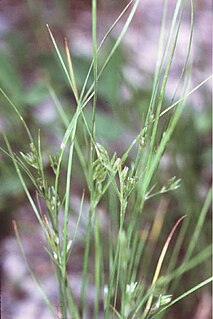
Juncus tenuis, the slender rush, is a clump-forming, round-stemmed perennial in the Juncaceae. Slender rush grows to be between 15 and 60 cm tall. Generally considered a weed, it is rarely sold by retailers as a household container plant. Where it is introduced, it is colloquially called path rush, field rush, slender yard rush, poverty rush or wiregrass.

Juncus bufonius, known commonly as toad rush, is a widespread flowering plant species complex in the rush family Juncaceae.

Juncus acutus, the spiny rush, sharp rush or sharp-pointed rush, is a flowering plant in the monocot family Juncaceae found throughout the Americas, Northern and Southern Africa, Western and Southern Europe and West Asia.

Juncus articulatus is a flowering plant species in the rush family Juncaceae. It is known by the common name jointleaf rush or jointed rush, which can also refer to J. kraussii from Australia. It is native to Eurasia, Canada, Greenland, and much of the United States. It grows in moist areas, such as wet sand, and thrives in calcareous soils. J. articulatus was found to be more sensitive to drought and salt stress than its congeners J. acutus and J. maritimus. It is a perennial herb producing mainly erect stems from a short rhizome. The stem may root at nodes, and it generally has one or more flattened hollow cylindrical leaves up to 10 centimeters long. Transverse internal partitions or joints may be seen or felt in the leaf of the plant.
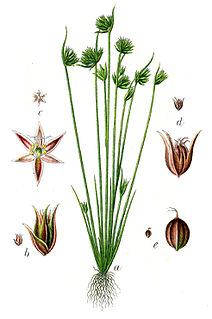
Juncus capitatus is a species of rush known by the common names dwarf rush and leafybract dwarf rush. It is native to Europe, Asia and North Africa. It is also an introduced species in parts of North America such as California and the Gulf Coast. It grows in moist areas, such as wet sand, vernal pools, and ditches.

Juncus kraussii commonly known as salt marsh rush, sea rush, jointed rush, matting rush or dune slack rush, is of the monocot family Juncaceae and genus Juncus. It grows in salt marshes, estuarine and coastal areas.
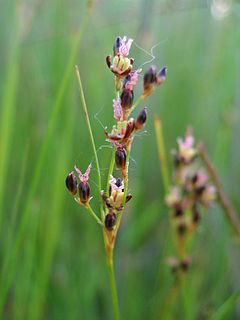
Juncus gerardii, commonly known as blackgrass, black needle rush or saltmarsh rush, is a flowering plant in the rush family Juncaceae.

Juncus acutiflorus, also called sharp-flowered rush, is a rush or a grassy plant of the genus Juncus. As the name suggests, the plant has notable sharp-looking flowers, flowering between July and September.
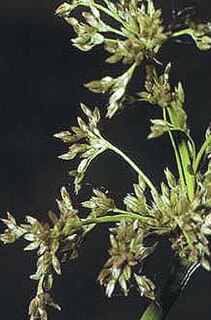
Juncus roemerianus is a species of flowering plant in the rush family known by the common names black rush, needlerush, and black needlerush. It is native to North America, where its main distribution lies along the coastline of the southeastern United States, including the Gulf Coast. It occurs from New Jersey to Texas, with outlying populations in Connecticut, New York, Mexico, and certain Caribbean islands.

Wellington College Bog is a 6.2-hectare (15-acre) biological Site of Special Scientific Interest in the grounds of Wellington College on the northern outskirts of Sandhurst in Berkshire.

Juncus australis is a species of rush known by the common names austral rush, leafless rush and wīwī. The species is native to south-eastern Australia and New Zealand, where it can be found around bodies of water. Its habitat is wet or seasonally wet grasslands and woodlands, and it can grow in dense and damp soil along rivers and creeks. It is a rhizomatous perennial rush that grows up to 120 centimetres tall. The plant flowers in clusters, with dense heads at the tip of the stem.
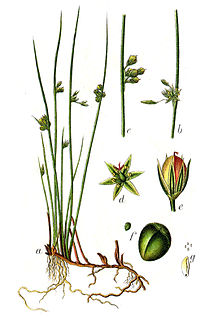
Juncus filiformis, called the thread rush, is a species of flowering plant in the genus Juncus, with a circumboreal distribution. It has been introduced to South Georgia Island. It is typically found in wetlands, on the borders of lakes and streams.
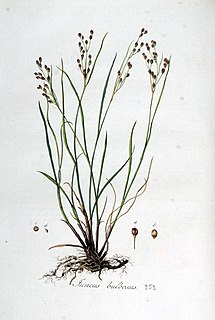
Juncus bulbosus, the bulbous rush, is a species of flowering plant in the genus Juncus, native to Iceland, the Faroes, Europe, Macaronesia, and northwest Africa. It has been introduced to Australia, New Zealand, and some locations in northern North America. It is capable of nuisance growth in lakes and streams.
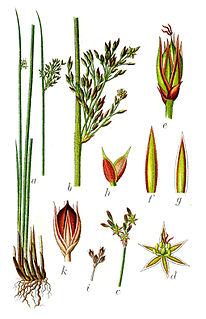
Juncus inflexus, the hard rush, is a species of flowering plant in the genus Juncus, native to Europe, Asia and Africa, and introduced in Sri Lanka, Java, Île Amsterdam and Île Saint-Paul, Victoria in Australia, New Zealand, Uruguay, and eastern North America. It is a glycophyte.
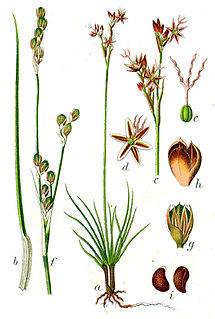
Juncus squarrosus, called goose corn, heath rush, and mosquito rush, is a species of flowering plant in the genus Juncus, native to Iceland, Europe, and Morocco, and introduced to Greenland, Svalbard, Tasmania, New Zealand, and the US state of Wisconsin. It is pollution-tolerant.

Juncus alpinoarticulatus, called the northern green rush and the alpine rush, is a species of flowering plant in the genus Juncus, with a circumboreal distribution. It prefers wet sandy soils, peat bogs, acidic fens, and ditches.

Juncus hybridus is a species of annual herb in the family Juncaceae (rushes). They have a self-supporting growth form and have simple, broad leaves.



















